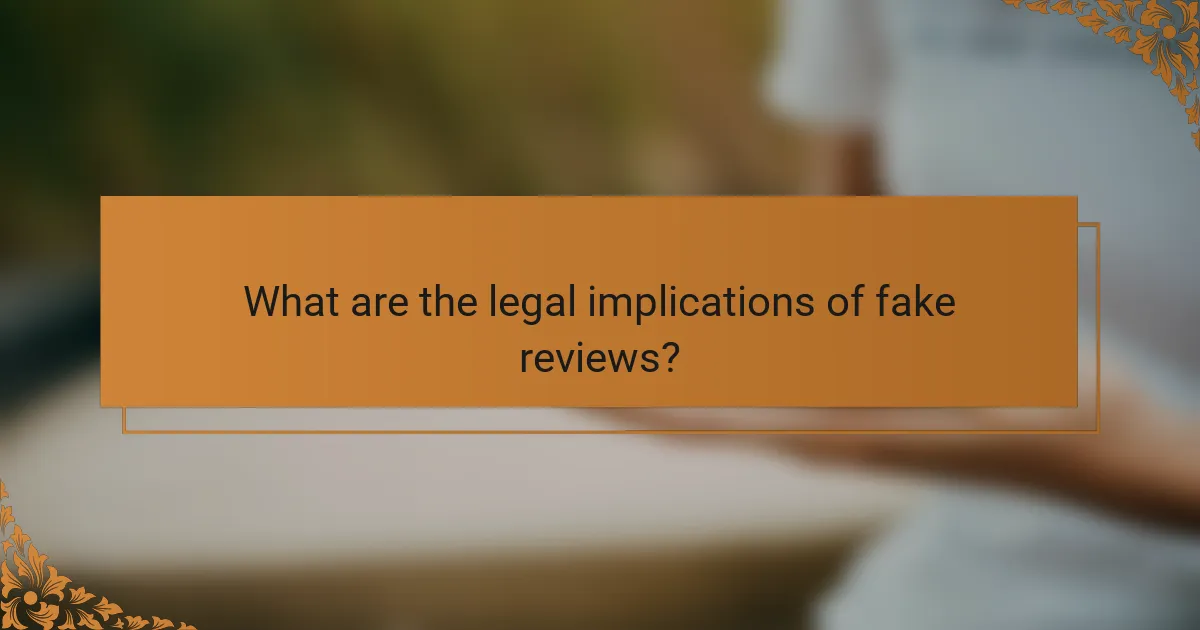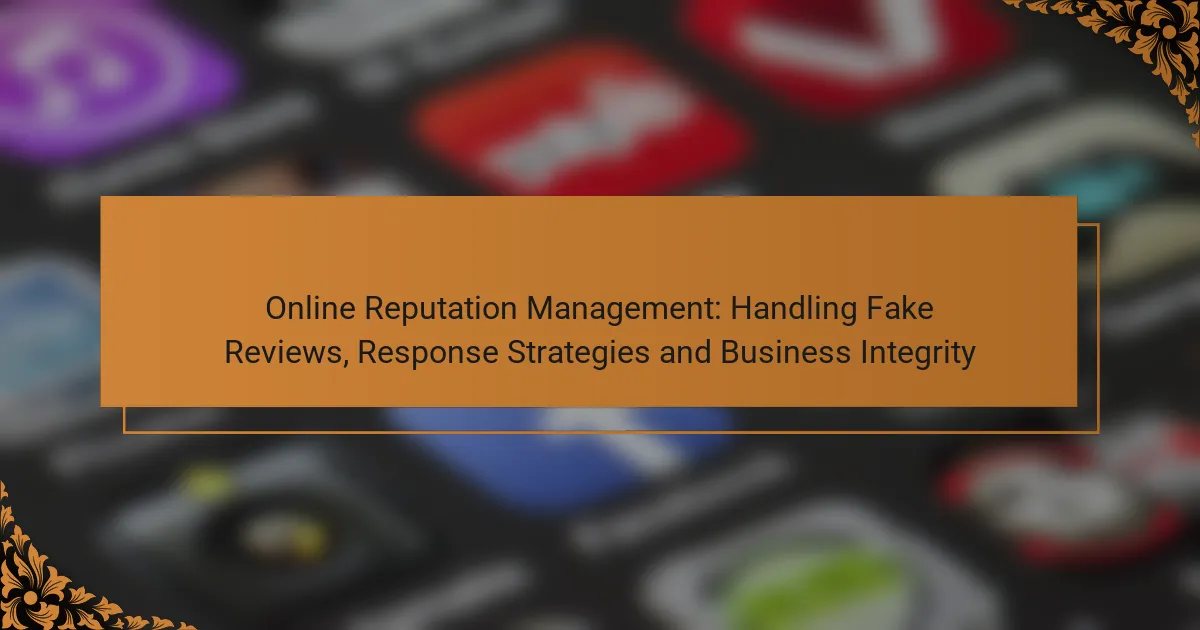In today’s digital landscape, managing online reputation is crucial for businesses, particularly in addressing fake reviews that can undermine trust. By implementing proactive strategies to identify and respond to these reviews, companies can uphold their integrity and foster customer confidence. Utilizing effective reputation management tools further enhances this process, allowing businesses to monitor feedback and maintain a positive brand image.

How to handle fake reviews in the UK?
To handle fake reviews in the UK, businesses should adopt a proactive approach that includes identifying, reporting, and responding to such reviews. This ensures the integrity of their online reputation while maintaining customer trust.
Identify fake reviews using tools
Utilizing online tools can help businesses identify fake reviews effectively. Platforms like ReviewTrackers or Trustpilot offer features that analyze review patterns and detect anomalies, such as multiple reviews from the same IP address or suspicious language. Regularly checking for these signs can save time and resources.
Additionally, businesses can monitor their review sites for sudden spikes in negative reviews, which may indicate coordinated attacks or fake postings. Keeping an eye on the overall sentiment can help in distinguishing genuine feedback from fraudulent entries.
Report fake reviews to platforms
Once fake reviews are identified, the next step is to report them to the respective platforms. Most review sites, including Google and Yelp, have clear guidelines for reporting fraudulent content. Businesses should provide as much evidence as possible, including screenshots and details about the reviewer’s activity.
Timely reporting is crucial, as platforms often have specific timeframes for addressing such issues. Following up on reports can also ensure that the review is taken down or flagged appropriately.
Engage with customers publicly
Publicly engaging with customers who leave reviews, whether positive or negative, is essential for maintaining a good reputation. Responding to fake reviews with professionalism can demonstrate to potential customers that the business values feedback and is committed to transparency.
When addressing fake reviews, it’s important to remain calm and factual. Provide context or evidence that counters the false claims without escalating the situation. This approach can help mitigate the impact of the fake review.
Gather evidence for disputes
Collecting evidence is vital when disputing fake reviews. This can include screenshots of the review, timestamps, and any relevant communications with the reviewer. If the review violates the platform’s guidelines, this evidence can support the case for removal.
Maintaining records of customer interactions and transactions can also help establish the legitimacy of the business’s claims. This documentation can be crucial if the dispute escalates or requires legal action.
Monitor review trends regularly
Regular monitoring of review trends is essential for early detection of fake reviews. Businesses should set up alerts for new reviews and analyze trends over time to identify any unusual patterns. This proactive approach can help in addressing issues before they escalate.
Using analytics tools can provide insights into customer sentiment and highlight areas for improvement. By understanding customer feedback trends, businesses can enhance their services and reduce the likelihood of negative reviews in the future.

What response strategies improve business integrity?
Effective response strategies enhance business integrity by fostering trust and transparency with customers. By addressing feedback thoughtfully, businesses can demonstrate their commitment to quality and customer satisfaction.
Craft personalized responses
Personalized responses show customers that their feedback is valued. Instead of using generic replies, reference specific details from the review to create a connection. For example, if a customer mentions a particular product, acknowledge it directly in your response.
Using the customer’s name and mentioning their experience can make your reply feel more genuine. This approach not only improves customer relations but can also encourage others to leave positive feedback.
Maintain a professional tone
A professional tone is crucial in all responses, especially when addressing negative reviews. Avoid emotional language or defensiveness; instead, focus on being respectful and understanding. This helps to de-escalate potential conflicts and showcases your business’s commitment to professionalism.
Using polite language and a calm demeanor can turn a negative situation into a positive interaction. Remember, potential customers often read these responses, so maintaining professionalism can enhance your brand’s reputation.
Address specific concerns
Directly addressing specific concerns raised in reviews demonstrates that you are listening and willing to improve. Identify the key issues mentioned and provide clear, actionable solutions or explanations. For instance, if a customer complains about slow service, outline steps you are taking to enhance efficiency.
This approach not only resolves the individual’s issue but also reassures other customers that you are proactive in addressing problems. Transparency in your operations can build trust and loyalty over time.
Encourage positive reviews
Encouraging satisfied customers to leave positive reviews can help balance out any negative feedback. After a successful purchase or service experience, consider sending a follow-up email thanking them and inviting them to share their thoughts online.
Offering incentives, such as discounts on future purchases, can motivate customers to leave positive feedback. However, ensure that this practice complies with local regulations regarding reviews to maintain integrity and avoid potential penalties.

What are the best online reputation management tools?
The best online reputation management tools help businesses monitor, manage, and improve their online presence. These tools facilitate the tracking of reviews, customer feedback, and overall brand perception across various platforms.
Google My Business
Google My Business is a free tool that allows businesses to manage their online presence on Google, including search results and maps. It enables companies to respond to reviews, post updates, and share important information like hours and contact details.
To optimize your listing, ensure that all information is accurate and up-to-date. Regularly engage with customers by responding to reviews, which can enhance your reputation and visibility in local search results.
Yelp for Business
Yelp for Business is a platform that allows businesses to manage their Yelp listings and interact with customers. It provides tools for responding to reviews, posting updates, and accessing analytics to understand customer engagement.
Consider using Yelp’s advertising options to increase visibility. However, be cautious about soliciting reviews, as Yelp has strict guidelines against incentivizing feedback, which could lead to penalties or removal from the platform.
Trustpilot
Trustpilot is a review platform that enables businesses to collect and respond to customer reviews. It is particularly useful for building trust, as many consumers rely on reviews before making purchasing decisions.
Utilize Trustpilot’s features to encourage satisfied customers to leave reviews. Engaging with both positive and negative feedback can demonstrate your commitment to customer satisfaction and improve your overall reputation.
Reputation.com
Reputation.com offers a comprehensive suite of tools designed for managing online reputation across multiple channels. It provides features for monitoring reviews, generating reports, and improving customer engagement.
This platform is particularly beneficial for larger businesses or those with multiple locations, as it allows for centralized management of brand reputation. Regularly review analytics provided by Reputation.com to identify trends and areas for improvement in customer perception.

How can businesses measure their online reputation?
Businesses can measure their online reputation by analyzing customer feedback, review ratings, and overall sentiment across various platforms. This assessment helps identify strengths and weaknesses in customer perception, guiding improvements in service and engagement.
Utilize sentiment analysis tools
Sentiment analysis tools help businesses gauge public opinion by analyzing text from reviews, social media, and forums. These tools categorize sentiments as positive, negative, or neutral, providing a clear picture of how customers feel about a brand.
Popular tools include Google Cloud Natural Language, IBM Watson, and various social media monitoring platforms. By regularly monitoring sentiment, businesses can quickly address negative trends and reinforce positive feedback.
Track review ratings over time
Tracking review ratings over time allows businesses to identify patterns and shifts in customer satisfaction. This can be done using spreadsheets or specialized software that aggregates reviews from multiple platforms.
For effective tracking, focus on key metrics such as average star ratings and the frequency of reviews. Aim to analyze these metrics monthly or quarterly to stay ahead of potential issues and celebrate improvements.
Conduct customer surveys
Customer surveys provide direct insights into consumer perceptions and experiences. These surveys can be distributed via email, social media, or on-site, and should include both quantitative and qualitative questions.
To maximize response rates, keep surveys concise and offer incentives, such as discounts or entry into a prize draw. Analyzing survey results can reveal actionable insights to enhance customer satisfaction and loyalty.

What are the legal implications of fake reviews?
Fake reviews can lead to serious legal consequences for businesses, including defamation claims and violations of consumer protection laws. Companies must navigate these legal implications carefully to protect their reputation and avoid financial penalties.
Understanding defamation laws
Defamation laws protect individuals and businesses from false statements that can harm their reputation. If a fake review contains untrue statements that damage a business’s image, the affected party may have grounds for a defamation lawsuit. Key considerations include proving that the statement was false, damaging, and made with negligence or actual malice.
In many jurisdictions, businesses can pursue legal action against the reviewer or the platform hosting the review. However, the process can be lengthy and costly, so it’s essential to weigh the potential benefits against the legal expenses involved.
Consumer Protection from Unfair Trading Regulations
Consumer protection laws, such as the Unfair Trading Regulations in the European Union, prohibit misleading advertising and deceptive practices, including fake reviews. These regulations aim to ensure that consumers receive truthful information when making purchasing decisions.
Businesses found to be involved in creating or promoting fake reviews may face fines or sanctions. It’s crucial for companies to implement strict policies against soliciting false reviews and to monitor their online presence actively to comply with these regulations.
